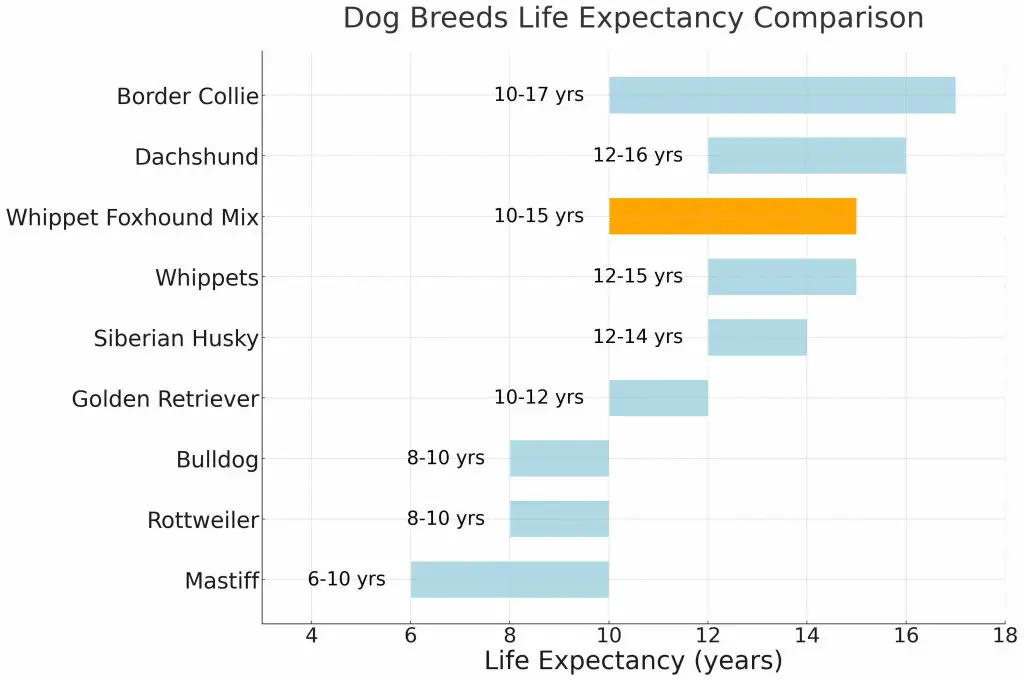
This is a complete guide to the Whippet Foxhound Mix, also known as the Foxwhip. So if you want to learn about:
- The personality of the Foxwhip
- Training and grooming requirements
- Health and lifespan
Then you’ll appreciate the comprehensive information in today’s guide. Let’s get started.
Quick Whippet Foxhound Mix Facts
Size: Medium to large, standing 20-25 inches (46 to 56 cm) tall.
Coat: Short and smooth.
Energy: High.
Suitability for Children: Excellent.
Life Span: 10-15 years.
Temperament: Gentle, affectionate, sociable, and energetic.
Training: Intelligent and energetic, requires consistent training.
Grooming: Moderate, with regular shedding.
Friendliness: Highly sociable and friendly.
Origin of the Foxwhip
The Foxwhip, a mix of Whippet and Foxhound, has a somewhat unclear history, which is typical for crossbreeds. We can learn more about the Foxwhip by looking at its parent breeds.
Origin of the Whippet
The Whippet’s true origin, which emerged in the late 18th or early 19th centuries, is still somewhat unclear. Depictions of small, smooth-coated dogs resembling Greyhounds have been found dating back to the 1400s.
At first, Whippets were used for hunting hares in open fields, even though they weren’t particularly good at tracking scents. This breed, often mistaken for Italian Greyhounds due to frequent crossbreeding throughout history, earned nicknames like the “Poor Man’s Racehorse” and the “Lightning Rag Dog.”
The name “Whippet” is believed to come from “whappet,” which means “a small dog that yaps.” In the early 20th century, textile workers from Lancashire brought Whippets to America. There, Whippet racing became popular. The American Kennel Club registered its first Whippet in 1888.
Origin of the Foxhound
The Foxhound originated in England in the 16th century. Initially bred for fox hunting, these dogs were greatly appreciated for their sharp sense of smell and endurance. They were developed by crossbreeding various types of hounds, resulting in a dog that was both nimble and resilient.
Over time, the Foxhound has split into two distinct types: the American Foxhound and the English Foxhound. Despite their common heritage, each type has unique traits influenced by their specific hunting roles and regional adaptations.
Whippet Foxhound Mix Appearance

The Foxwhip has a unique mix of physical traits from its parent breeds. It usually has the Whippet’s slim, sporty build and the Foxhound’s strong, muscular body.
Its coat is short and dense, giving it a smooth feel. The dog’s expressive eyes and alert ears add to its charm.
Colour
The Foxwhip’s coat colour can change a lot. This is because of the different colours of its parent breeds. It might have the Whippet’s solid colours, like black, white, red, fawn, or blue. Or it might have the Foxhound’s pattern of black, white, and tan.
Some Foxwhips might even have a brindle or spotted coat. This makes each one uniquely beautiful.
Size
A Foxwhip’s size can range from medium to large. They typically stand between 20-25 inches (51-64 cm) tall and weigh between 25-70 pounds (11-32 kg).
Typical Temperament Traits
Mixed breed dogs, such as the Foxwhip, often show a mix of their parent breeds’ personalities. They might have a strong instinct to chase and a curious nature. These dogs can be affectionate and loyal, but they may seem distant with strangers at first.
However, they adapt to new surroundings quickly, making them a good fit for active families. Despite their low maintenance needs, they still need basic care to flourish.
Whippet Personality
Whippets are gentle and loving. They’re usually calm and quiet, enjoying the company of their human friends. Despite their racing background, Whippets aren’t overly active and are happy with a moderate amount of exercise.
They’re also intelligent and can be trained easily, though they can sometimes be stubborn. Whippets are typically good with children and other dogs, making them a good choice for families.
But, their strong hunting instinct can make them a poor fit for homes with smaller pets.
Foxhound Personality
Foxhounds are famous for their friendly and sociable behaviour. They are lively dogs that love being around others, both dogs and humans.
Their hunting background gives them a strong sense of determination and persistence. Despite their lively nature, they are also known for their patience and tolerance. This makes them excellent family companions.
Whippet Foxhound Mix Combined Temperament
The Foxwhip’s nature is a charming blend of the Whippet’s tender affection and the Foxhound’s sociable energy. This breed is usually friendly, adaptable, and loves being part of a family.
They might show the Whippet’s calm behaviour at home, while their Foxhound heritage may encourage a love for outdoor activities and social interactions. But, like all mixed breeds, individual temperaments can vary, and a Foxwhip’s personality may lean more towards one parent breed than the other.
Raising a Foxwhip Puppy
Raising a Foxwhip puppy involves socialisation, training, and grooming. You should introduce your puppy to different environments, people, and other animals. This helps build confidence and teaches good behaviour.
Instead of punishing bad behaviours, guide them towards a positive alternative. Training should be practical and include positive reinforcement.
Grooming needs are minimal, with the Foxwhip requiring little to keep the coat smooth and neat. This breed may shed slightly but is not hypoallergenic. Both parent breeds are known for their cleanliness, so your Foxwhip should stay neat.
A monthly bath will help clean the coat and remove any dirt.
Whippet Foxhound Mix Socialization
Socialising is vital for a Foxwhip, blending the Whippet’s shy nature with the Foxhound’s friendliness.
Introducing them to different environments, people, and animals from a young age can help develop a confident, well-rounded adult dog.
Socializing With Other Dogs

Foxwhips usually show a friendly attitude due to their Foxhound heritage. But, their Whippet traits might make them slightly shy at first. They should meet different dog breeds, sizes, and temperaments from an early age to encourage good interactions.
Regular trips to dog parks or setting up playdates with other dogs can help. Keep in mind, every dog is different, so patience and positive reinforcement are vital for successful socialisation.
Socializing With Children
The Foxwhip’s gentle nature and sociable traits make it a good family pet. It’s friendly and has moderate energy levels, offering a mix of playfulness and calmness.
But, during playtime, you should watch over them to keep both the child and the dog safe.
Training And Exercise
A Foxwhip, similar to its Whippet parent, needs plenty of exercise to use up energy. This means as many outdoor activities as possible. At least an hour of play, walking, or running in the park is suggested.
This breed flourishes with both physical and mental stimulation, which helps their overall health. Training is also vital for the Foxwhip to build good relationships with people and other pets.

You should start training as early as possible. This breed can be hard to train if not started early. Tools like the structured 8-week guide for puppies or the Zigzag puppy training app, which provides a personalised programme, can help in this process.
Space Requirements
Foxwhips are energetic and need plenty of space to roam and play. A home with a large, fenced garden would be ideal.
But, they can adjust to flat living, as long as they get enough exercise every day. Regular walks and playtime in a local park can make up for a lack of indoor space.
Whippet Foxhound Mix Health And Care
The health of a Foxwhip can be influenced by its lineage. This mixed breed may inherit potential health issues, requiring regular vet check-ups and a balanced diet for the best health. But, details vary with each individual dog.
Grooming Requirements: Do Whippet Foxhound Mixes Shed?
Whippet Foxhound mixes do shed, possibly more than their Whippet parent because of the Foxhound’s influence. Whippets have short coats and don’t shed heavily, needing only a small amount of grooming.
But, they’re not hypoallergenic, shedding as much as any other breed. You’ll notice the shedding most in the spring and autumn. Regular brushing can help control the shedding, reducing the amount of fur around the house.
Whippet Health
Whippets, like all breeds, can have specific health problems. These might include heart conditions like mitral valve disease and arrhythmia, and eye issues such as cataracts. They can also have a blood disorder called von Willebrand’s Disease.
Moreover, because of their slim build, Whippets can be sensitive to extreme temperatures and might need extra attention in cold weather. Regular vet visits and a balanced diet can help keep them healthy.
Sources: PetMD
Foxhound Health
Foxhounds, similar to Whippets, may be prone to certain health problems. Common issues include unexplained weight gain and lethargy, which could suggest underlying health issues.
Skin problems, hair loss, and allergies are also widespread. Environmental allergens and food allergies are often the cause. Symptoms of these allergies can vary from itching, frequent licking or scratching, and hair loss, to more serious reactions like skin lesions, runny nose, sneezing, coughing, or wheezing.
As Foxhounds get older, arthritis can become a problem, causing pain, joint stiffness, and inflammation. But, Foxhound mixes generally have a low risk of hip dysplasia.
Regular grooming, including monthly baths, is needed to keep a healthy coat and remove any dirt stuck under the fur.
Sources: Animal Health Clinic
Whippet Foxhound Mix Health
Foxwhips might face health problems like unexplained weight gain, tiredness, skin issues, hair loss, and allergies. Allergies to things in the environment like mould, grass, pollen, and dust, or food allergies to beef, chicken, eggs, dairy, soy, wheat, and corn can cause skin allergies.
These allergies can also lead to a runny nose, sneezing, coughing, or wheezing. Arthritis, which causes pain, joint stiffness, and inflammation, is another possible issue.
Inherited conditions from the Whippet parent, such as von Willebrand’s disease, deafness, sinus problems, and allergies, might also affect a Foxwhip.
Regular exercise, a healthy diet, and proper care can help a Foxwhip live for 13 to 15 years.
Life Expectancy
The lifespan of a Foxwhip can be estimated by looking at the life expectancies of its parent breeds. Whippets usually live between 12 to 15 years, while Foxhounds live for 10 to 12 years.
So, a well-looked-after Foxwhip can be expected to live between 10 to 15 years. Like all breeds, good care and regular vet check-ups can lead to a longer, healthier life.

Rescuing A Whippet Foxhound Mix
Rescuing a Whippet Foxhound mix can be a rewarding experience. Bonnie, a Whippet mix, was initially used as a sled dog. But, her early retirement was due to her shyness around other dogs, especially about food.
Despite this, Bonnie smoothly transitioned into her new role as a companion dog, showing the adaptability of this breed. The owner of WhippetCentral, who is also Bonnie’s guardian, has successfully raised many Whippets. This shows that with patience and understanding, these dogs can do well in a home environment.
Rescuing a Foxwhip not only gives a loving home to a dog in need, but also brings a loyal and adaptable companion into your life.
Where to Find A Whippet Foxhound Mix Puppy
Finding a Foxwhip puppy can be tricky because the breed isn’t well-known. But, you can start your search by contacting breed-specific rescue organisations or shelters. These places often have mixed breed dogs and can help you find a Foxwhip puppy.
Online platforms and social media groups dedicated to Foxwhips can also be helpful. Always check the credibility of the source to avoid supporting unethical breeding.
Remember, getting a puppy is a lifelong commitment, so take your time to find the right Foxwhip for you.
Whippet Foxhound Mix Breeders
Finding good breeders for a Whippet Foxhound mix may need some careful searching due to the breed’s relative rarity. Breeders should prioritise the health and temperament of their dogs over just looks.
A decent breeder should provide health clearances for both parent breeds. This shows that the dogs have been checked for common health problems. They should also welcome visits, letting potential owners meet the puppies and their parents at home.
Online platforms like the American Kennel Club (AKC) provide breeder referral services, which can be a useful starting point. But, adopting a mixed breed dog like the Foxwhip can be a great choice, giving a loving home to a dog in need.
Adopting a Mix Breed Dog. Cost and Challenges
Adopting a mixed breed dog, such as the Foxwhip, can bring financial considerations and unique challenges. Adoption costs can vary greatly, influenced by factors like the dog’s age, health, and the adoption agency or rescue centre’s policies. Puppies often have a higher adoption fee due to the vaccinations and other initial veterinary care they need.
The breed’s rarity may also affect the adoption cost. As Foxwhips are not common, finding one for adoption could be harder and potentially more expensive.
Adopting a mixed breed dog like the Foxwhip brings challenges beyond the financial. These dogs may have unknown health histories or behavioural issues, needing patience and possibly professional training. But, the rewards of providing a loving home to a dog in need can far outweigh these challenges, making adoption a fulfilling choice for many potential dog owners.
FAQs
We answer the most common questions about the Whippet Foxhound Mix below.
What are the different names for a Whippet cross Foxhound?
The Whippet Foxhound mix, or the Foxwhip.
Does the Foxwhip Breed Bark a Lot?
Foxwhips, similar to their Whippet parent, usually aren’t very vocal. They might bark to warn their owners about outdoor animals or surprise visitors, or to communicate needs like playtime or hunger. Some might even bark during play or when they’re frustrated.
But, the frequency and reasons for barking can differ among dogs, with some being louder than others. Barking at specific triggers like squirrels might be due to particular situations or learned behaviour.
Is the Whippet Foxhound Mix Breed Intelligent?
The Foxwhip is recognised for its natural intelligence, especially in hunting, and its capacity to learn by watching. This breed also shows high adaptive intelligence, meaning they can learn from past experiences and their surroundings.
While adaptive intelligence can differ among individual dogs, most Foxwhips are particularly good in this area. But, in terms of obedience and working intelligence, they rank 96th among dog breeds.
Other Popular Posts
- Whippet Catahoula Mix: Ultimate Guide
- Whippet French Bulldog Mix: Ultimate Guide
- Whippet Dalmatian Mix: Everything You Need To Know
- Whippet Boston Terrier Mix: A Full Guide
- Whippet Basenji Mix: A Comprehensive Guide

Hello. I’m Luke- the founder of WhippetCentral. I’m somewhat of a whippet nut and have been for most of my life. In that time, I’ve owned and raised numerous whippets. Bonnie is my latest girl; she is currently eight years old and keeps me very busy! Understanding the need for whippet-specific content, I decided to create this blog to share what I have learned and to share my expertise regarding owning and raising whippets – the right way!
